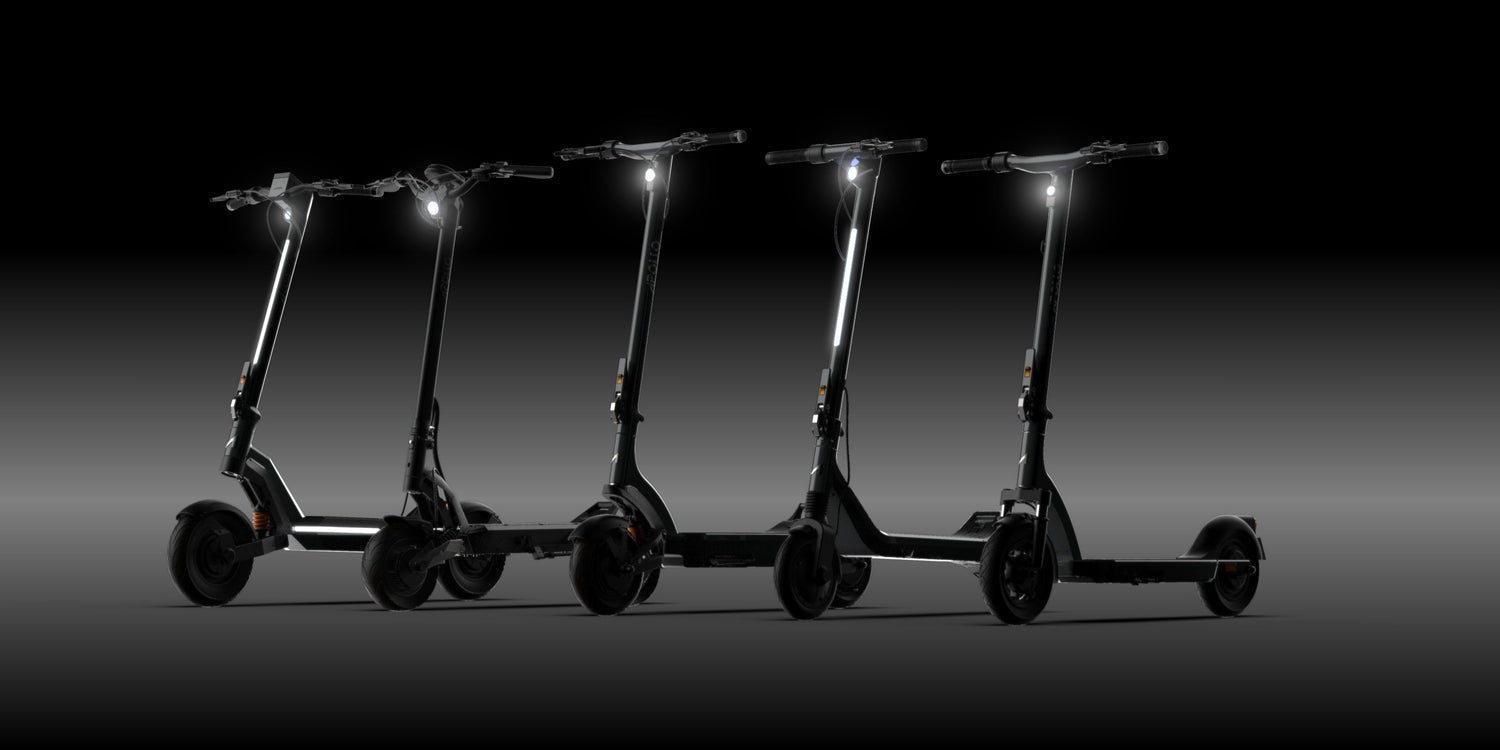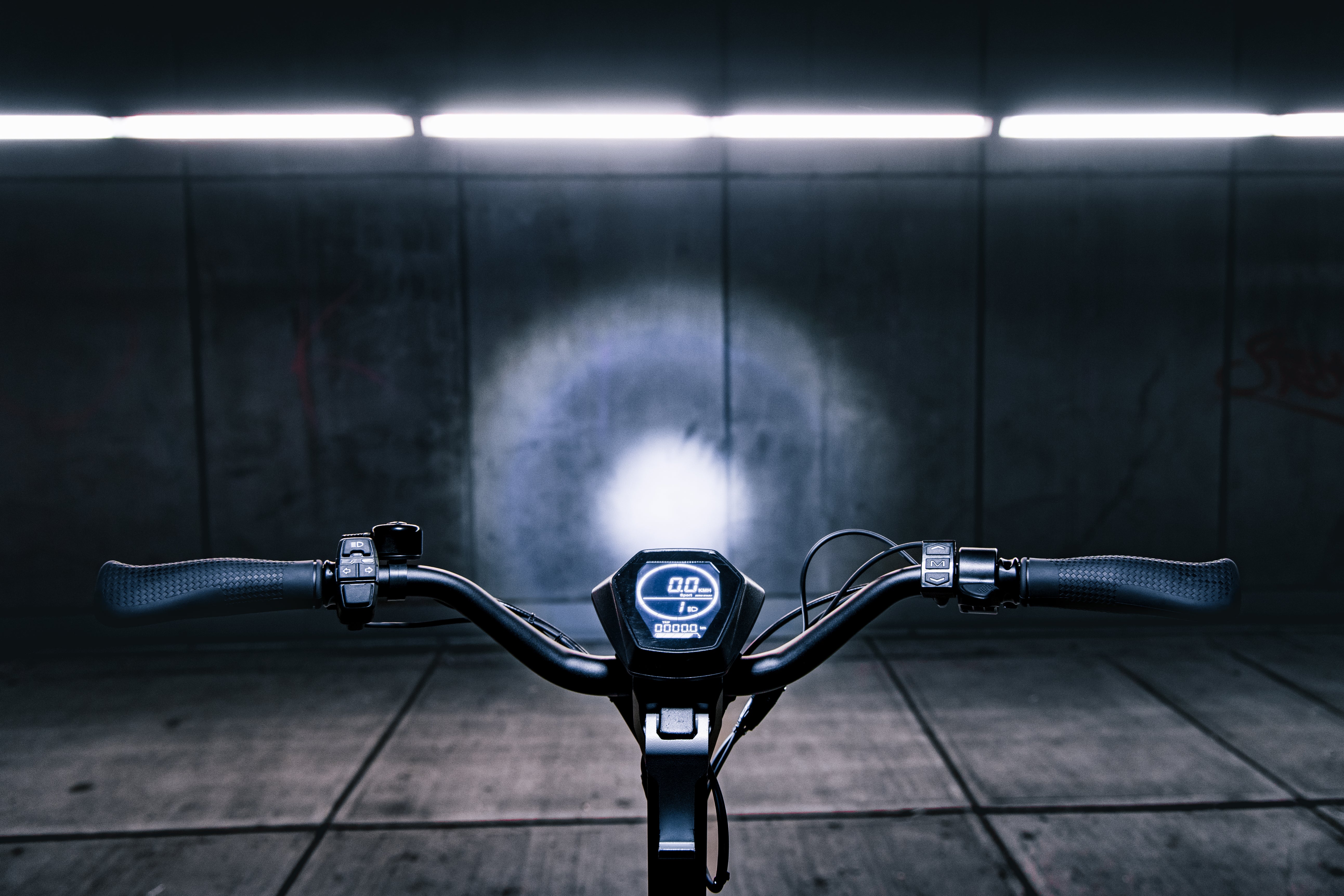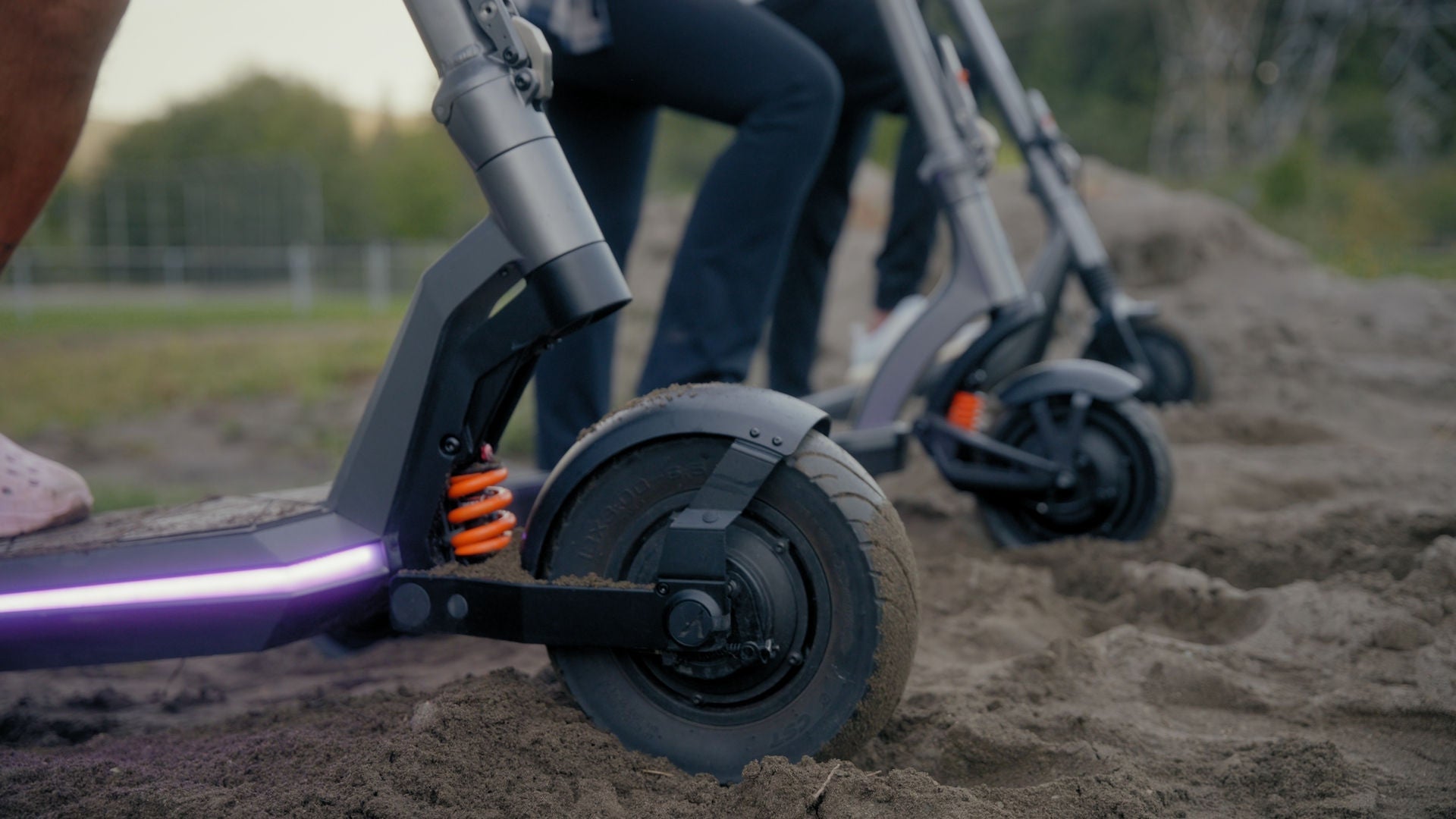Electric Scooters Demystified - Exploring Different Types and Functions
In this article we will explore some of the key aspects of electric scooters. Helping you demystify the terms and specifications used in describing the myriads of options available. In addition to the most basic scooter attributes of cost of electric scooters, range of electric scooters, how fast electric scooters are, we will delve into other important factors including the advantages and limitations of dual motor / single motors, and other performance enhancements. Also, how your use case, such as commuting, recreation, and logistics will impact your needs and choice.
The Three H’s of Electric Scooters
On the base level people always want to know the Three H’s of electronic scooters. 1. How Much, 2. How Far, and 3. How fast. There is some good news and some bad news. First the bad news. Finding the right scooter for you is more complicated than that. Now the good news. Like so many other transport and recreational devices, the myriads of options offer so many individual solutions that once you begin to understand the various aspects you are likely to be able to select a scooter that really meets your transport and/or recreational needs.
Let’s start out with the Three H’s. Bear in mind this is the most basic and crude level of evaluation. You will later wan’t to go much deeper than that to optimize your choice.
How Much: Considering the Cost of Electric Scooters
The easiest parameter to understand is how much. Electric scooters are available from a number of manufacturers. If you are reading this, you are either familiar with or getting acquainted with Apollo scooters. There are a number of scooters available from Apollo and others at various price points. Generally starting from just under $400 to upwards of $ 5000 CAD. While there is certainly a place for super budget scooters, those costing less than around $700, one should be aware that these scooters can have their limitations and potential pitfalls. In addition to offering fewer features, durability and reliability can be concerns, as well as safety.
Regardless of what scooter you ride, remember that you will be standing on this device and going at some speed. Having a critical mechanical failure could not only strand you somewhere, but also result in a crash, and possible personal injury. This applies both to the initial purchase as well as sustained maintenance of the scooter.
These devices are made practical by the incorporation of very high energy density batteries. Notably many Lithium Ion based battery cells are put together in a battery pack with BMS (Battery Management System). The BMS not only optimizes the charging and balancing of the individual battery cells, it is also critical to battery pack longevity and safety. In a poorly designed/fabricated constructed ebike or scooter these batteries can become a fire hazard. In a quality designed system, especially one that is UL certified (Underwriters Laboratory) battery fires are near non-existent. In addition to more robust safer design and construction greater cost also affords higher performance and features.
How Far: Determining the Ideal Range for Your Electric Scooter
Much like electric automobiles, the range of a scooter is dependent upon a number of factors, including battery capacity, terrain, speed and rider weight. In the case of electric scooters as opposed to automobiles, rider weight comprises a significant difference. Think about the weight of a 200 pound (90 kg) driver or a driver and passenger weighing 320 pounds (145 kg) together in a Tesla Cybertruck. The diver or driver and passenger is very small, almost insignificant change in the total weight of the vehicle. In the case of the Cybertruck 5% or less depending upon the model options. Whereas a scooter weighs between 30 and 120 pounds (10- 55 kg).
Almost any adult rider will more than double the weight of even the largest scooter. Larger scooters are capable of taking adults of greater than 300 pounds (136 kg). With most, even smaller light weight scooters, rated to up to at least 220 pounds (100kg). In addition, like electric cars, and bicycles, depending upon the manufacturer, the marketing claims of range can be let's just say “optimistic”. One should consider that the starting range when they are being “honest” is applicable to flat (not hilly) runs at 24 km/h, with a 160 pound (72 kg) rider. Ranges are typically stated from 19 km on the low-end scooters to up to 96 km for certain high-end models. Note that greater range is not always “better”. In addition to generally greater acquisition cost for nominally equivalent scooter models that offer additional range, there is an additional weight penalty as well.
How Fast: Understanding Maximum Speed for E-Scooters
Electric Scooters designed for adult use are capable of maximum speeds from 25 km/h to roughly 96 km/h depending upon the model. Obviously the more expensive ones tend to have generally greater speed capabilities. The stated speeds are often only achievable under certain conditions. Generally, 165 pound riders (75 kg), flat ground, fully charged batteries etc. Most of us have encountered ride sharing scooters, these are limited to 25 km/h, due to insurance and municipal regulations. In addition, many municipalities have speed limits for riding scooters. In the United States the statutory speed limits vary from 25 to 30 km/h on public roads. These limits apply to the operation of the scooter, not an enforced hardware limitation.
In the EU and some other nations, there are enforced hardware limitations. With sensible safe riding, exceeding speeds of 25km/h is rarely enforced. Typically, in uncrowded open conditions, speeds of under 50 km/h don’t attract the attention of law enforcement. Judgement is key. For commuting and general transport most will find that traveling at roughly 30 km/h is a sweet spot. Taking a scooter over 40 km/h is really a recreational pursuit for those “with the need for speed” as there is no escaping the physics of 8 to 12” wheels and relatively short wheelbases.
Now that we have covered the three H’s, let's do a deeper dive into more complex features and terms and how they might impact you.
Finding what scooter is right for you should start with an analysis of your “use case”. To begin, ask yourself the following questions:
-
Primary intent – commuting and or recreation. Within these, what does your commuting look like – how far? Is it mixed (train then scoot the last mile)? What is your idea of recreational use? Touring the local town, RV'ing, thrill seeking? Long rides?
-
Storage and charging at your residence. Do you have to get up stairs, in an elevator, your building may require (and you should have it anyway) UL certification?
-
Transporting the Scooter. Are you planning on using the scooter for hybrid transport mixed with public transport for commuting, chores, recreation?
-
Any after dark use?
-
Hills, and road surfaces?
-
How far do you really need to ride between charges?
-
Do you want to know lots about your rides?
Once you determine your intended use case, you can then get a general idea of the Three H’s, and move beyond that to look at other factors which we will discuss below. We will go through these use cases and discuss how the various scooter attributes impact the scooter’s ability to ideally fulfill your individual use case(s).

Terms to Know When Shopping for an Electric Scooter
Let’s go through some terms now and look at how they might impact your use case.
Dual Motors and Single Motors
Scooters are available with electric motors either on a single wheel, or both wheels. Single motor scooters at the least expensive price tier, use a single motor in the hub of the front wheel. Dual motors have motors almost always of equal power in the hubs of both wheels. Most dual motor scooters have the ability to operate only supplying power to one wheel if the rider chooses. The advantage of Dual Motors is significantly increased driving force (torque) and traction. This is particularly useful when tacking steep grades or less than ideally paved surfaces such as dirt paths. The disadvantages are increased cost and weight of the scooter.
On level ground dual motors don’t automatically mean increased speed but can impact it positively in most cases. Most dual motor scooters have the ability to shut off power to one of the motors – single motor operation. There doesn’t seem to be a reason for most riders to use this function as dual motor scooters don’t seem to gain significant range from operating on a single motor.
Motor Power
The electric motors on scooters are specified in wattage. The wattage of a motor is power it is capable of consuming. This is closely related to the amount of torque the motor will be able to produce. (Note that all motors do not have exactly the same efficiency so it is possible that one 800 watt motor will be “more powerful” than one from another maker. For our purposes, we can safely assume that more watts = more power delivered to the road.
Typically, two specifications are given. When comparing motors make sure you are comparing the same specification. There are nominal and peak wattage figures given for scooter motors. The nominal wattage is the sustained capability of the motor. For most this is the more important of the two. Common ratings are 350W, 500W, 800W, and 1000W motors continuous power in Watts with even greater power levels available at the high end. Note that in the US, scooters are legally mandated to be maximum 750W (total power so 375W each in a dual motor system). This seems to never have been enforced however and is rarely observed in sales or marketing of mid range to high end scooters. Other nations will vary on the enforcement front (usually banning import and sales, as well as operation). You can expect scooters with a total motor wattage of 300 watts or less to achieve speeds of roughly 25 km/h on standardized test conditions (level ground, full battery, 165 pound rider etc). Dual motor 1000W each will go into the mid to high 30s, maybe even low 40s.
Battery Voltage, AH (Amp hours or Milli-amp Hours) and Watt hour
The capacity of a scooters battery system (Lithium Ion in modern scooters at time of this writing), is specified in few ways. Nominal Voltage is the measured voltage of the cells at approximately half their full charge (like water pressure), Amp Hours is the amount of current capacity (like gallons of water) and Watt hours is the total energy that that battery can deliver (Voltage x Amp Hours). What do these mean to us? One would normally only care about watt hours since that will tell us the actual total amount of work the battery can do. However, voltage can also come into play for reasons too complex to get into here.
Let’s just say that higher voltages are needed to get the most power out of more powerful motors. Your super fast and big hill climbing scooters tend to need higher voltage battery packs. Larger AH for a given voltage battery system also increases watt hours (total work capacity) but this generally impacts range more than maximum speed. Common voltages are 36V, 48V and 60V with a few rare crazy speed scooters (95 km/h class) using 72 volts. Greater watt hours, is not necessarily always the preferable scooter. Buying more watt hours than you need will not only increase the cost of the scooter, but also the weight. This can be an impediment to transporting the scooter, storing it, and doing maintenance, where the scooter needs to be lifted or carried. Many of the faster scooters are over 100 pounds (45 kg). Some well over that; the batteries are a significant part of that weight.
Scooter tires
Scooter tires came in many diameters and widths. Other important factors to consider are tread type, and tube – tubeless and solid (airless). Sizes start at 8” for smaller and ride sharing scooters and high performance scooters can be up to 12” in diameter. Width from about 1.5 inches to 4 inches. Bigger isn’t always better. For a given motor power, a smaller wheel has more effective delivery of torque (accelerate faster, and tackle a steeper hill), at the same time the maximum speed and range may be slightly reduced. Larger tires can handle larger road obstructions and offer a smoother ride in general.
The smaller 8” tires are offered predominantly either with inner tubes, or as solid airless tires. Some of the airless types have holes strategically molded into them to make them not so rigid. These airless types are preferred by some because they don’t require filling with air and they are not prone to flats.
Larger tire sizes are offered with inner tubes or tubeless. It’s not an end user choice, rather it is a manufacturer design choice based upon the design of the rims that tires mount on. While the ride quality is very similar, the tubeless designs are generally more puncture resistant than tire with inner tubes. Additionally on the rider side, punctures in tubeless tires can often be patched without removing the tire. Whereas tubed tires require taking off the tire and tube to repair, either replacing or patching the tube. This is much more difficult.
Split rims
Split rims are a design of the tire rims that splits in half greatly simplifying tire changes and repairs. While generally split rims only supported tubed tires, recent designs have expanded split rim designs to accommodate tubeless tires.
Another term you may run across is “Regenerative Braking”. Regenerative Braking is a technology that converts the motors to generators when the rider wishes to slow the scooter down. Either coming up to stops, turns, or maintaining speed on descents. In addition to prolonging brake shoe life, regenerative braking also provides some recharging energy to the battery potentially extending range. In a well designed system regenerative braking is so smooth and progressive that conventional friction braking (drums or disks) need not be used at all. This is one of the areas that Apollo excels at.
Scooter apps
Many scooters of recent design come with Apps (Smartphone Applications). These Apps can be for iOS (iPhones) and Android (most of the other smartphones). Apps predominantly serve two basic needs as well some advanced ones. 1. To make setting up and personalizing your scooter easier. There used to be a hidden menu system called “P” settings that was difficult to set up and make changes to. The things that used to be done with P settings are not handled by the scooter’s App. 2. To give the rider more advanced information about the current state of the scooter than the built in display can efficiently do.
The advanced functions of Apps include assistance with navigation. Ride metrics, Ride histories, and even sharing ride information with others! Using apps allows manufacturers to add some advanced features to scooters without modifying the hardware or firmware. The ride sharing feature for example was recently debuted by Apollo, working across its scooter line. The collection of advanced ride metrics including battery, controller and others allows the manufacturer to assist customers with troubleshooting some malfunctions should they occur. Apps can also enhance security by allowing the user to lock and unlock the scooter with the phone. Other security and enhancements are supported by some scooters and Apps, including Apple “find my” and Internet of Things connectivity that supports remote metrics, positioning and security even when the scooter is not turned on. Apps, and hardware support for remote services are an area that is dynamic and getting more sophisticated every year.

Choosing a Style of Electric Scooter to Suit Your Needs
High Performance Electric Scooters
High Performance Scooters can be a great option, especially for recreational use. The ride can be thrilling. A sense of speed going 55 km/h on a scooter feels like 144 km/h in a car and costs tens of thousands less to purchase, operate and maintain the vehicle that does this. Scooters with this type of performance start at a cost of around $ 2,500 and go up from there. Remember that speed is just one part of the feature set of a scooter. However, performance even with an electric scooter comes at a price. Higher initial cost, higher parts costs, tires for example, higher weight, larger size. These factors make transport and storage difficult, and can attract unwanted attention which could invite theft, law enforcement, and not being welcome places you could bring a less imposing scooter such as inside your workplace, supermarket, health club.
Electric Scooter for Commuting
Using a scooter for commuting where one is able to is a fantastic option. It can save money and time, as well as make the day more engaging and pleasurable. This in addition to the positive impacts upon environmental sustainability and reducing traffic.
A commuter scooter is one less large vehicle on the road, and one less parking space at your destination. This can have a financial impact as well as save time in a number of urban commutes. Right sizing your scooter can be very important here. Bigger isn’t always better. For example comparing two Apollo scooters on a commute. The Go and the Pro. The Go is lighter at 49 pounds (22 kg), not as powerful. It is a 350 watt each dual motor, versus the Pro at 93 pounds with 1200 watt each motor. If your commute is long: more than 5 miles each way, or has very rough pavement or requires high speed (greater than 32 km/h), the Pro might be a great choice. However, if you are hybrid (train, bus, car rather than scooter), or you have stairs, the light weight and very compact folding size of the Go will be near ideal. Large fast scooters are 90 pounds (40 kg) and up, with longer wheelbases. More range and speed, at the expense of increased weight and cost. Storage in the office can be an issue. A Go can often be stashed in a cube or closet while a Pro is larger, too heavy to do stairs and calls attention to itself walking through an office hallway. Mid Sized Scooters like the Apollo City are a little of both. The City being 65 Pounds with 500W each.
As an addendum to using a scooter for commuting is used for local transportation. Many areas both rural and urban have efficient routes that are available to pedestrians, bicycles and scooters that can be utilized by scooters. Often end to end these routes can be more convenient than using cars, or other transportation options. Everyday errands for example. The type of scooter ideal for these trips is one that will make the trip in the most convenient way possible. Again look at the scooter that meets the needs, while one that is “overkill” may not accomplish the job as well as a “lesser” performance scooter will do.
Another consideration for commuting, errands, and recreation is lighting. If one is out at night with the scooter, lighting can also be very important, even worth consideration of additional head lighting for fast riders in night scenarios. More and more quality scooters are coming with good lighting. This lighting serves two purposes. 1, allowing the rider to see what is ahead at night. 2, perhaps of even greater importance, is allowing others, especially automobiles to see the scooter at dusk and at night. This lighting should include a high mounted headlight and turn signals viewable from the front and rear.
Recreational use is another consideration. While thrill seekers may wish to invest in a really fast electric scooter. Something with dual motors of 1000W plus, and a high-capacity battery. That will deliver endless Adrenalin pumping speed and race up the steepest hill >56 km/h on flats. Others may find that going 25 km/h is quite enjoyable cruising speed, with 30 km range more than adequate. These people will have the enjoyment of scooter travel in a much more affordable package that is easier to transport, store and take trips with. Still others may really like the super light scooter, where 20 km/h and a 24+ km range is more than adequate. They will be able to purchase a scooter that they can just bring with them on trips, toss in the car for a ride in the park or store under or inside their RV for use in the RV park and surrounding areas. Easy to pick up and inexpensive to acquire. It’s all about right sizing for your use case.
Choosing a High-Performance Electric Scooter from Apollo Scooters
Electric scooters have revolutionized personal transportation, offering a variety of options tailored to different needs, budgets, and lifestyles. If you're looking for a scooter for commuting, recreation, or hybrid use, understanding your use case is vital to making an informed choice. At Apollo, we offer a wide range of electric scooters to suit every rider's preferences, from budget-friendly models to high-performance machines. Whether you're a commuter seeking reliability, a thrill-seeker chasing speed, or someone balancing multiple needs, Apollo has you covered. Explore our selection today to find the perfect scooter for your lifestyle!






